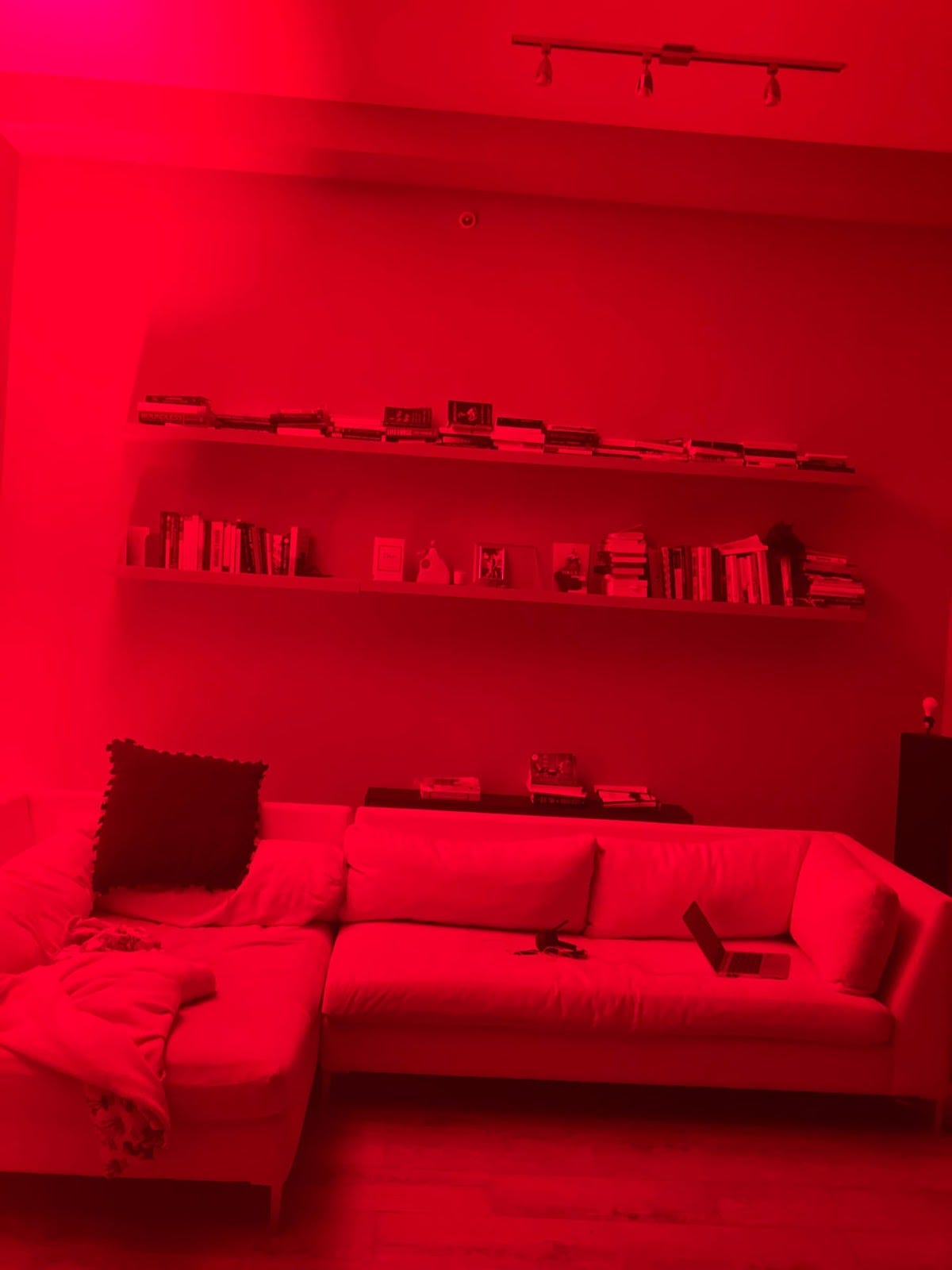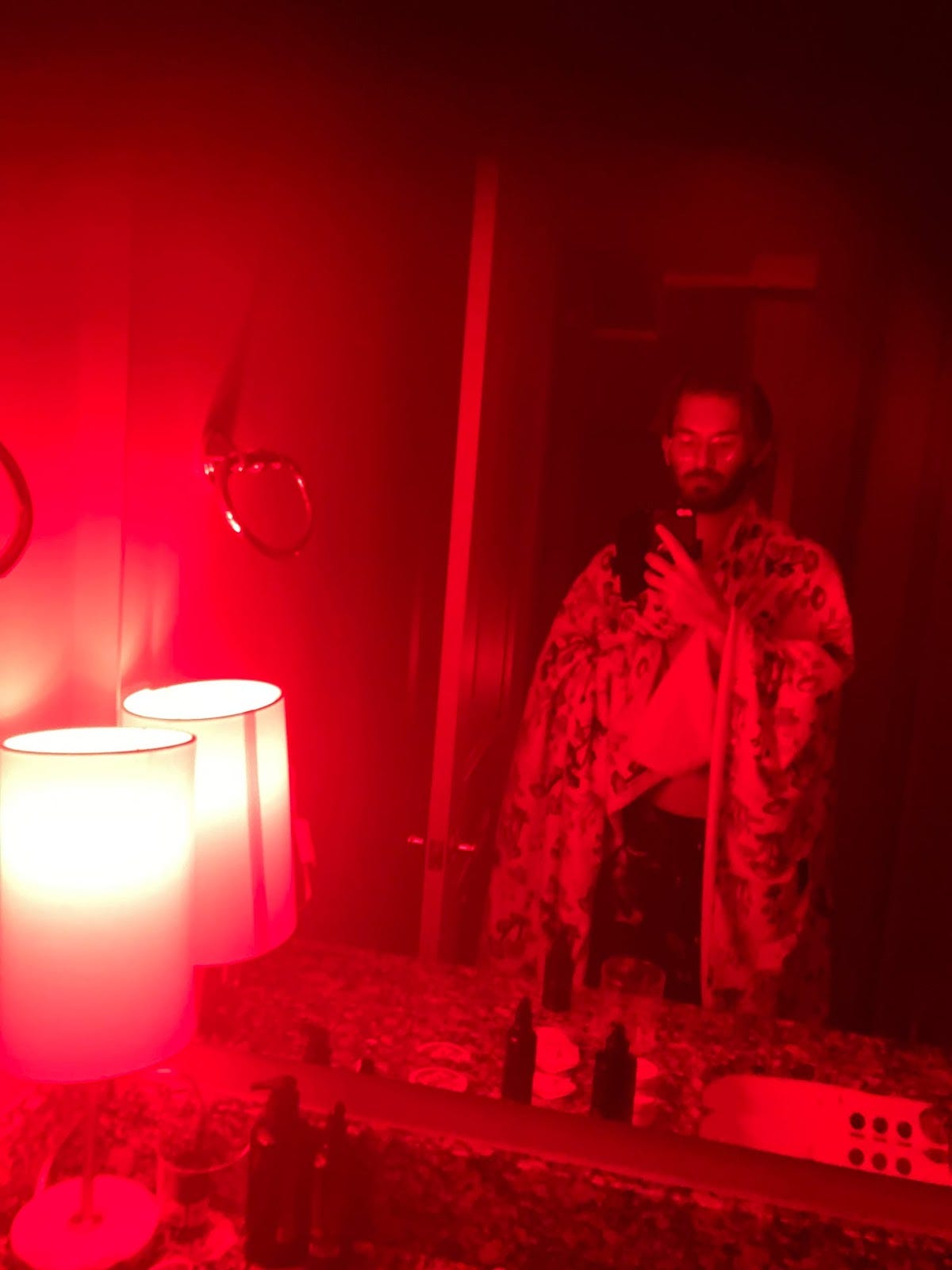I use red lights to help me sleep better–and you can, too
It also gives me more energy during the day
Let me share with you one of the most effective biohacks I’ve ever tried.
Red light at night.
Yes, red light.
Every night I make my apartment look like a mix of a German techno rave and the Amsterdam red light district. I bathe in red light like Michael Phelps in an Olympic swimming pool.
What’s crazy is I now fall asleep much easier, sleep longer, and wake up with more energy.
I began questioning this back in my junior year of college. There are common topics in biohacking like energy, sleep, and recovery–and one factor that boosted these was light. Yes, light. Light is the most impactful part of our environment.
Our bodies are designed to respond to the amount of light around us and adjust our energy levels, hormones, and biochemical processes accordingly.
Why light is so important for our body
For example, when our eyes detect bright light—like morning sunlight—photons are absorbed, sending a signal to the brain that says, "It’s bright out, time to wake up!" This triggers a healthy release of hormones like cortisol and adrenaline, which help us kickstart the day.
Conversely, when our bodies sense darkness at night, a different signal is sent to the brain, telling it to produce serotonin and melatonin, which help us relax and fall asleep.
Another example has to do with hormones,
For instance, men experience spikes in testosterone around 7 am, 2 pm, and again at 5 pm, before it drops off at night. We likely evolved this way because we needed energy for activities like hunting and mating during the day, while night time was meant for rest. Same goes for women with estrogen, progesterone, and testosterone spiking at different times of the day.
So natural light from the sun triggers healthy hormonal responses, regulates our sleep wake patterns and just makes us feel good.
But here’s the problem
We live in a modern world where light bombards us all the time. Not just any light, but artificial light.
I’m in Dallas, and at night the sky gets lit up by streetlights, hotel signs, and cars. We spend hours on smartphones, tablets, and computers before bed, all of which emit unhealthy amounts of artificial light. This artificial light disrupts our body's natural sleep-wake cycle by suppressing melatonin production, making it harder for us to wind down and fall asleep.
Using bright LED lights or fluorescent lighting in the evening, especially in bedrooms or living areas, can trick the brain into thinking it’s still daylight, which prevents us from relaxing before bed.
You might have heard of some people talking about blue light and how it's bad. Artificial light has super concentrated amounts of blue light, unlike the sun which has a full spectrum of colors
And here’s the kicker—this blue light is really bright and ultra-concentrated. It’s a powerful agent that promotes wakefulness. When our bodies get hit with this fat dose of blue light at, say, 8 pm, it tells the body, "It’s time to wake up!" even though it’s evening. Our eyes don’t know the difference—we’ve been tricked. So, you end up struggling to fall asleep because your body thinks it’s still daytime.
So, what can we do about it?
The good news is that you don’t have to turn your life upside down to correct this. . You can still enjoy the things you love—like watching TV, hanging out with friends in the evening, or even going to the club.
There are a lot of ways to do this, so I’ll tell you what I’ve done for my house and the tools I use.
Step 1: Where the blue lights at?
The first step I would suggest is to understand where the blue light is coming from. You look outside and think, damn, it’s bright out there—lots of LED near my bedroom window. Ok, that’s your first step. Get some blackout curtains and cover that sh*t up!
Do a thorough audit of all the blue light sources in your home. How bright are your screens? Do your appliances emit light?
Figure out where the blue light is coming from so we know where to put our solutions.
Step 2: Get some Red Lights
Since we’re focusing on red light for general lighting (not for medical use), there are plenty of affordable options. You don’t need to drop a thousand dollars on a high-end Joovv panel.
You can either get a small panel that will do a pretty good job at lighting your house, or you can switch out some lamps with red light bulbs.
I personally have both so my apartment can be bright with red light but still relaxing enough that I fall asleep.
Here's what I use. I'm sure you can look up “red light bulbs” on amazon and find a ton of options.
I have one small hooga panel.
And then these bon charge red light bulbs for 3 lamps in my house.
Bon Charge also has mini lamps that you can travel with, which is awesome.
For context, I’ve installed red light bulbs in two lamps in my bedroom. Once the sun goes down, I turn off all LEDs and use only these lamps. I’ve also placed a red light bulb in my bathroom for nighttime use. In the living room, I use a large red light panel and a red light lamp so we can still hang out comfortably.
Step 3: Reduce Blue Light Exposure
Ok now your apartment has lots of red light at night. This is great.
Now turn off all the lights in your apartment. What’s lighting it up? I know you see the blue light. Is it coming from your fridge, your oven, or your clock?
We need to cover that up.
I highly recommend getting some blackout tape, which is what I did to my fridge here. I also recommend getting these blackout stickers that Dave Asprey made. You can put them on your alarm clock, fridge, or whatever.
Here is the link to the stickers
Next, let’s look at your screens.
You can get an app or software called f.lux that has a blue light blocking filter. The whole screen turns red and still allows you to use it. My girlfriend and I love using it at night. Once it hits sunset, I turn off all the blue light on the app, and we watch Netflix.
Lastly, and probably my favorite, is blue light-blocking glasses. I love wearing these while driving, working late, and going out. They keep my eyes relaxed and still allow me to fall asleep at night. Not all of them are equal, though. Amazon has horrible blue light glasses. I did research, looked into eye health, and this guy who made RA optics is a legend. These are the best on the market. I highly, highly recommend them.
Step 4: Focus On Daytime Lighting, Too
Even during the day, LEDs can be stressful on the eyes and contribute to eye degeneration. I recommend switching to incandescent bulbs for a safer and more relaxing light source.
Also there are light bulbs and lamps that mimic natural sunlight. Bon charge has a great one.
Step 5: Maximize Natural Sunlight
Last but not least, get as much natural sunlight as possible in the morning and afternoon. This exposure will boost your serotonin levels, which, in turn, will help you produce more melatonin at night.
Additional Resources
For a deep dive into the science behind lighting and health, check out articles by
He breaks down the research beautifully and is a great resource for further reading.
Book a free call with me today.
With Love,
Jack (Kool Health)







Great article, Jack. I legitimately had no idea about red lighting and its effect on sleep until I read this article. Massive respect on your dedication to eliminate blue lighting from your apartment.
Oooh, I love all these tips! 💖 I use blue light glasses from Swanwick. They work so well I can’t travel without them! Gonna try the red lights in our room. My sons says if I put them in the hallway, it will make the house look creepy like “hell”. 🤣🤣🤣